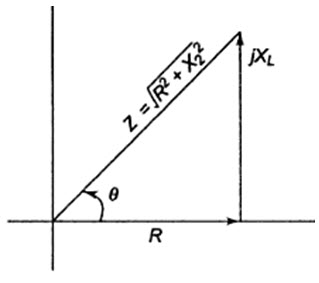Site pages
Current course
Participants
General
Module 1. Average and effective value of sinusoida...
Module 2. Independent and dependent sources, loop ...
Module 3. Node voltage and node equations (Nodal v...
Module 4. Network theorems Thevenin’ s, Norton’ s,...
Module 5. Reciprocity and Maximum power transfer
Module 6. Star- Delta conversion solution of DC ci...
Module 7. Sinusoidal steady state response of circ...
Module 8. Instantaneous and average power, power f...
Module 9. Concept and analysis of balanced polypha...
Module 10. Laplace transform method of finding ste...
Module 11. Series and parallel resonance
Module 12. Classification of filters
Module 13. Constant-k, m-derived, terminating half...
LESSON 19. Reactive power and power triangle
19.1. Reactive Power
We know that the average power dissipated is
\[{P_{av}}={V_{eff}}\left[ {{I_{eff}}\,\,\cos \,\theta } \right]..................................................\left( {19.1} \right)\]
From the impedance triangle shown in fig. 19.1
\[\cos \;\theta \,=\,{R \over {\left[ Z \right]}}..................................................\left( {19.2} \right)\]
\[and\,\,{V_{eff}}\,\,=\,\,{I_{eff}}\,\,Z..................................................\left( {19.3} \right)\]
If we substitute Eqs (19.2) and (19.3) in Eq. (19.1), we get

Fig.19.1
\[{P_{av}}`={I_{eff}}\,\,Z\,\left[ {{I_{eff}}\,{R \over Z}} \right]\]
\[=\,\,\,I_{eff}^2\,\,R\,\,watts..................................................\left( {19.4} \right)\]
This gives the average power dissipated in a resistive circuit.If we consider a circuit consisting of a pure inductor, the power in the inductor.
\[{P_r}=i{v_L}..................................................\left( {19.5} \right)\]
\[=iL\,{{di} \over {dt}}\]
Consider \[i={I_m}\,\sin \,(\omega t\, + \,\theta )\]
Then \[{P_r}=I_m^2\,\sin \,\left( {\omega t + \theta } \right)L\omega \,\,\cos \,\,\left( {\omega t + \theta } \right)\]
\[={{I_m^2} \over 2}\,\left( {\omega L} \right)\sin \,\,2\,\,\left( {\omega t + \theta } \right)\]
\[\Pr=I_{eff}^2\left( {\omega L} \right)\,\sin \,2\,\left( {\omega t + \theta } \right)..................................................\left( {19.6} \right)\]
From the above equation, we can say that the average power delivered to the circuit is zero. This is called reactive power. It is expressed in volt-amperes reactive (VAR).
\[{P_r}=I_{eff}^2\,{X_L}\;\,VAR..................................................\left( {19.7} \right)\]
From Fig.19.1, we have
\[{X_L}=Z\sin \,\theta ..................................................\left( {19.8} \right)\]
Substituting Eq. 19.8 in Eq. 19.7, we get
\[{P_r}=I_{eff}^2\,Z\,\sin \,\theta \;\]
\[=\left( {{I_{eff}}Z} \right){I_{eff\,}}\sin \,\theta\]
\[=\,{V_{eff}}\,{I_{eff}}\,\,\sin \,\theta \,\,VAR\]
19.2. The Power Triangle
A generalized impedance phase diagram is shown in Fig.19.2. A phasor relation for power can also be represented by a similar diagram because of the fact that true power Pav and reactive power Pr differ from R and X by a factor I2eff as shown in Fig. 19.2.
At any resultant in time, Pa is the total power that appears to be transferred between the course and reactive circuit. Part of the apparent power is true power and part of it is reactive power.
\[{P_a}=I_{eff}^2\,Z\]
The power triangle is shown in Fig19.2
From Fig. 19.3, we can write
\[{P_{true}}={P_a}\cos \,\theta\]
or average power Pav = Pa cos θ
and reactive power Pr = Pa sin θ

Fig.19.2 Fig. 19.3